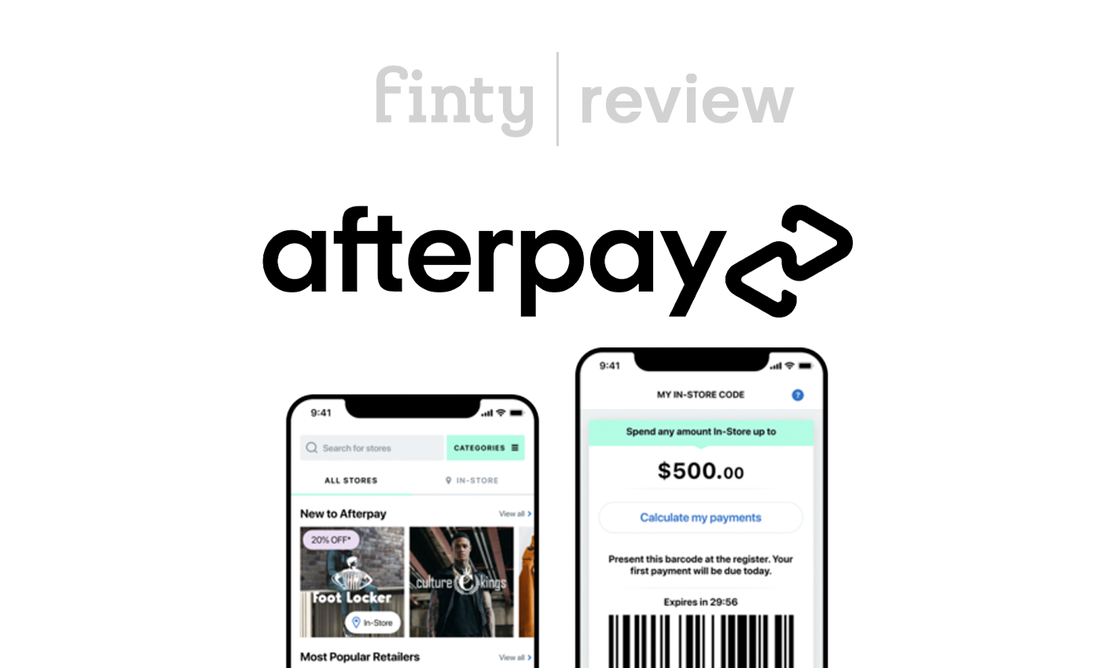- Afterpay offers a simple purchase repayment plan at thousands of retailers.
- Pay a 25% deposit, take your purchase home, pay the balance in three more instalments.
- No interest charges, but late payment fees apply.
Looking for a way to buy something now, receive your product, and then pay it off in regular instalments? Afterpay is one of several Buy Now Pay Later (BNPL) services offering eligible shoppers short-term financing options at participating retailers.
For those who can meet the once-per-fortnight repayment schedule, items appear more affordable when split into four smaller payments. But is there a catch? Read on to find out whether Afterpay lives up to the hype.

Inside this review
What is Afterpay?
Afterpay is a Buy Now Pay Later (BNPL) service founded in Sydney in 2014 by Nick Molnar and Anthony Eisen. Its shares currently trade on the Australian Securities Exchange (ASX: APT) and NASDAQ (AFTPF) and the company operates in Australia, UK, US, Canada and New Zealand. It has been acquired by American payments company Square, Inc, with the deal to be completed by March 2022.
How does Afterpay work?
Account set-up
Shop in-store or online at thousands of Afterpay partner retailers and choose Afterpay as your payment method at the checkout. First-time users create an account – with an instant decision on whether the account has been approved – while returning customers just need to log in.
Mobile app and virtual payment card
In-store shoppers need to download the Afterpay mobile app and set up the virtual Afterpay card to make a contactless payment. Afterpay pays the retailer for the full amount of the purchase after deducting a percentage service fee payable by the retailer, and the shopper then pays Afterpay, not the retailer, for their purchase.
Pay by instalments
A 25% deposit is payable at the time of purchase, and the remainder of the purchase price is split into three more instalments payable to Afterpay at two-weekly intervals. For example, a $100 purchase would require a $25 deposit plus three more payments of $25 each spread over the following six weeks. Payments are taken automatically from a debit or credit card you link to your Afterpay account when setting it up.
Credit limit
Afterpay's credit approval process is not comprehensive. Initially your credit limit is likely to be small, but will increase the more often you use Afterpay and make timely repayments. You can potentially have many purchase and repayment transactions active in your account at the same time, rather than having to pay off each purchase before you can make another.
How much does it cost to use Afterpay?
Afterpay's big selling point is that it does not charge interest on the debts being repaid by instalments, so in this sense Afterpay is completely free to use from the shopper's point of view. Afterpay makes a large part of its profit from the service fee it deducts when covering the purchase price for the retailer.
However, Afterpay does charge late payment fees, which can work out to be very expensive if you don't have enough credit limit left in your credit card, or enough funds in the bank account linked to your debit card, when Afterpay tries to collect repayments. Potentially, a $10 fee will be charged each time you miss a payment, with a further charge of $7 if the payment is not made within seven days. But fees are capped at 25% of the purchase price or $68, whichever is less.
This means that on a $40 purchase you could incur $10 in late payment fees, and on a $300 purchase you could incur $68. On a short-term debt that would easily work out to be much more expensive than paying interest, even at the high rates of interest charged on credit cards. Your ability to make further purchases using Afterpay will also be suspended while you have an overdue payment.
In short, using Afterpay is interest-free, but not necessarily cost-free if you spend more than you can afford to repay.
Who is Afterpay designed for?
Afterpay is popular with millennials, students, and people on lower incomes. It appeals to users who are more likely to make impulse purchases they can't immediately afford, but recoil from a credit card's high interest rate and possible annual fee. It's also usually easier and quicker to get an Afterpay account approved than it is to open a credit card account.
Users need to be reasonably tech-savvy in order to download the app, key in identity verification details (e.g. from driving licence, Medicare card, passport) scan and verify their linked debit or credit card and set up the virtual Afterpay card in Google Pay or Apple Pay.
What's better - BNPL or credit cards? Read more in our informative article about Afterpay vs credit cards.
Pros and cons
Pros
- Interest-free payment by instalments, because Afterpay's profit mostly comes from service fees charged to retailers.
- Quick and easy account set-up and approval, with no formal credit check.
- Take your purchases home immediately, instead of having to wait until they are paid for in full (as was the case with 'lay-by').
- Thousands of retailers accept Afterpay, both in-store and online.
- Payment at checkout is fast and simple –just a contactless payment in-store, or choosing your Afterpay account as your payment method online.
Cons
- Late payment fees, if incurred, can work out more expensive than credit card interest.
- Facilitates impulse buying and shoppers spending more than they can afford, which can lead to serious financial difficulties.
- Can have a downward impact on your credit history andcredit score, because using Afterpay can affect your credit score, even though they say they don't report late payments to credit bureaus. Afterpay debt may also make it harder to be approved for other forms of credit, such as a personal loan or home loan.
- Afterpay is not regulated by APRA (Australian Prudential Regulation Authority), so it is not bound by the National Credit Code. Its credit checks are less extensive and irresponsible spenders may have their account approved.
Alternatives
Compare Australia's BNPL services on our buy now pay later services comparison page. Here are some of the more popular ones.
- Zip Pay. Afterpay's chief competitor in Australia. Widely accepted in stores and online.
- Humm. Offers interest-free credit for ten weeks (spread over five fortnightly or 10 weekly payments). Works for small purchases up to $2,000 and larger spending amounts up to $30,000. Late payment fees can be incurred.
- Openpay. Flexible plans, easy repayment and no interest. Shop in-store or online and choose from 1 - 24 months instalments.
- Klarna. Interest-free credit with purchase amount repayable over four instalments paid fortnightly. Lower late payment fee than Afterpay.
- Beforepay. Get up to $1,000 of your already earned wages instantly, without waiting for payday. No interest, just a 5% transaction fee and repayment over up to four pay cycles.
The verdict
As with all forms of debt, Afterpay works best for people who already have their finances and spending under control. They will be able to use it without incurring fees, although it may not be any more useful to them than a credit card with no annual fee.
But for anyone liable to spend regularly on impulse and make frequent purchases they cannot afford to repay, Afterpay could work out to be a very expensive form of borrowing.

